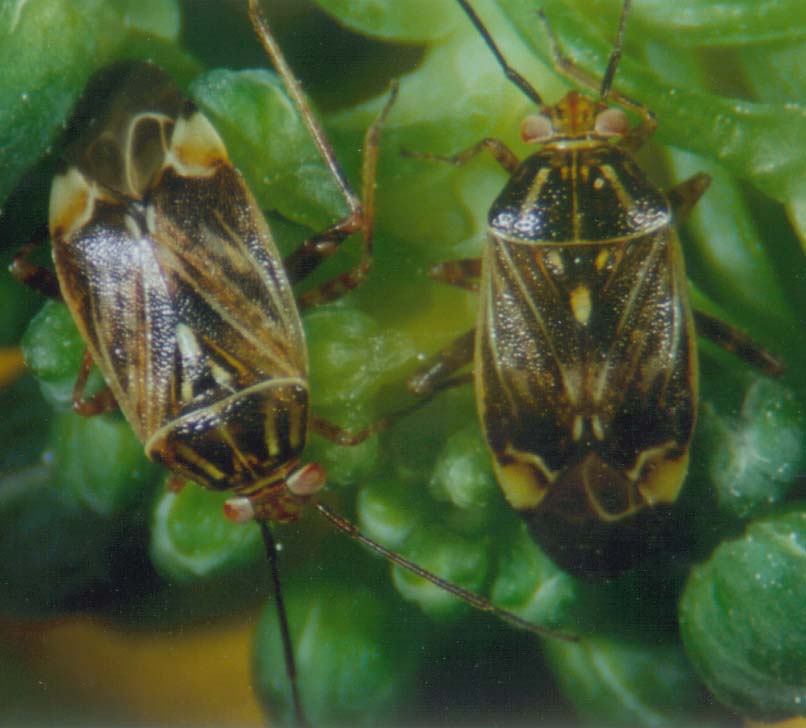
FIELD, VEGETABLE & BERRY IPM
Spotted Wing Drosophila
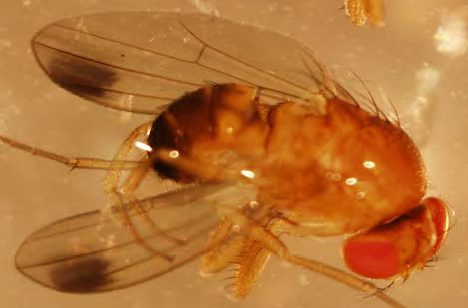
The Spotted Wing Drosophila (SWD), Drosophila
suzukii, was first discovered in the western US 2008 and is now well-established
throughout North America. Female SWD lay eggs in ripe and ripening fruit. This
insect is a pest of most berry crops, cherries, grapes and other tree fruits,
with a preference for softer-fleshed fruit such as raspberries, blackberries,
blueberries. Larvae developing in fruit affects marketability and
dramatically reduces storage time. It was detected in ME, NH & VT in 2011.
Western Bean Cutworm
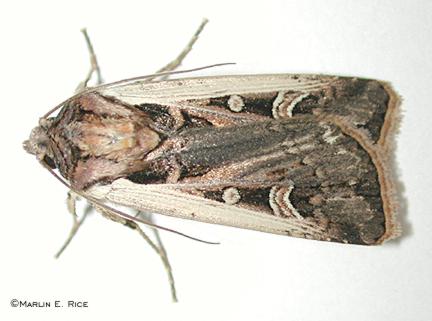
The western bean cutworm (WBC), Striacosta albicosta, is a late season pest that attacks corn (including field, sweet and popcorn) and both dry and snap beans. Moth larvae feed on developing kernels in husks or beans in pods causing economic damage. Infestations involve multiple larvae per ear causing substantial losses. This moth is native to North America, and prior to 2000 losses occurred only in the western Corn Belt states. It has been on an eastward expansion. It was found in Ontario in 2008, Pennsylvania and New York in 2009, and Vermont in 2011.
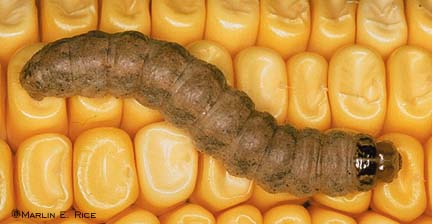 | 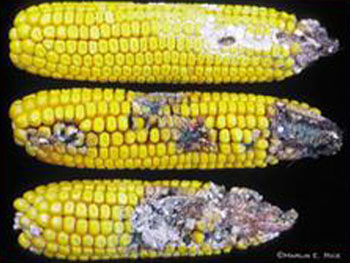 |
| WBC Larva | WBC Damage to Corn |
This is an emerging pest in the Eastern US.
If you are a VT farmer and you think you have WBC, please contact the Entomology Laboratory at (802) 656-5434 or cfrank@uvm.edu.
2014 VT WBC Survey Data
| Date | County | Town | No. WBC Adults |
| 7/25/14 | Addison | Shoreham | 1 |
| 7/30/13 | Franklin | Fairfield | 2 |
| 7/30/13 | Franklin | Enosburg | 1 |
| 7/30/13 | Franklin | Sheldon | 3 |
| 7/30/13 | Franklin | Swanton | 1 |
| 7/31/14 | Rutland | East Wallingford | 7 |
| 7/31/14 | Rutland | North Clarendon | 2 |
| 7/31/14 | Rutland | Rutland | 2 |
| 7/31/14 | Addison | Shoreham | 18 |
| 7/31/14 | Addison | Addison | 9 |
| 8/12/14 | Rutland | East Wallingford | 2 |
| 8/12/14 | Rutland | Rutland | 3 |
| 8/12/14 | Addison | Shoreham | 19 |
| 8/12/14 | Addison | Addison | 2 |
| 8/15/14 | Franklin | Fairfield | 7 |
| 8/15/14 | Franklin | Sheldon | 9 |
| 8/15/14 | Franklin | Georgia | 10 |
| 8/25/14 | Addison | Addison | 1 |
| 8/29/14 | Franklin | Sheldon | 1 |
| 2014 Total | 100 |
2013 VT WBC Survey Data
| Date | County | Town | No. WBC Adults |
| 7/26/13 | Chittenden | South Burlington | 1 |
| 7/26/13 | Rutland | East Wallingford | 2 |
| 7/26/13 | Rutland | Rutland | 1 |
| 7/26/13 | Addison | Shoreham | 4 |
| 7/26/13 | Addison | Addison | 1 |
| 8/1/13 | Franklin | Sheldon | 1 |
| 8/8/13 | Rutland | East Wallingford | 1 |
| 8/8/13 | Addison | Shoreham | 4 |
| 8/8/13 | Addison | Addison | 3 |
| 8/8/13 | Chittenden | South Burlington | 3 |
| 8/23/13 | Addison | Shoreham | 1 |
| 2013 Total | 22 |
2012 VT WBC Survey Data
| Date | County | Town | No. WBC Adults |
| 7/11/12 | Addison | Shoreham | 1 |
| 7/11/12 | Addison | Addison | 6 |
| 7/27/12 | Addison | New Haven | 3 |
| 7/27/12 | Rutland | E. Wallingford | 3 |
| 7/27/12 | Addison | Addison | 30 |
| 7/27/12 | Addison | Shoreham | 24 |
| 7/27/12 | Rutland | N. Clarendon | 2 |
| 8/1/12 | Franklin | Fairfield | 1 |
| 8/1/12 | Franklin | Sheldon | 1 |
| 8/1/12 | Franklin | Georgia | 1 |
| 8/7/12 | Addison | Addison | 4 |
| 8/7/12 | Addison | Shoreham | 3 |
| 8/7/12 | Rutland | E. Wallingford | 2 |
| 8/21/12 | Rutland | E. Wallingford | 1 |
| 2012 Total | 82 |
Results from the NYS Weekly Field Crops Pest Report that contains additonal WBC survey data can be found at: http://nysipm.cornell.edu/fieldcrops/tag/pestrpt/default.asp
Please visit Pest Watch for information on several key pests: http://www.pestwatch.psu.edu/
For additional WBC
information, please visit the following websites:
http://www.ext.colostate.edu/pubs/insect/05538.html
http://ipm.illinois.edu/vegetables/insects/western_bean_cutworm/
http://learningstore.uwex.edu/assets/pdfs/A3856.pdf
http://ento.psu.edu/extension/field-crops/corn/western-bean-cutworm
Brown Marmorated Stink Bug
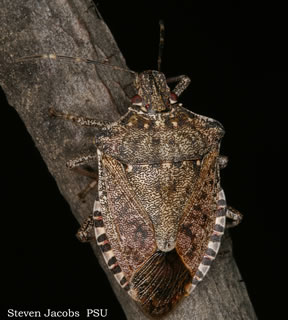
The brown marmorated stink bug (BMSB), Halyomorpha halys, is one of the latest exotic invasive pests to reach northern New England, and it is expected to have a major impact on vegetable and fruit production in the future. There have been several sightings in Vermont in 2011 and 2012. It is known to feed on over 300 plants, many of which are important food crops. Damage to crops in New Jersey and Pennsylvania in 2011 was estimated to be in the millions. It also is a serious nuisance pest, when it enters homes in the fall in large numbers. To date, no chemical pesticide or biological control agent has been found to be particularly effective. UVM ERL scientists have been testing the effectiveness of the commercial insect-killing fungus Botanigard against the adult stage in laboratory trials. Three concentrations of the fungus were tested, and the highest rate killed 67-100% of the adults within 12 days. More research is needed to determine how best to use this microbial product under field conditions.
Several other naturally-occurring insects are often mistaken for the BMSB. Click HERE for a fact sheet on the BMSB as well as their common look alikes.
If you suspect you have BMSB and are unable to identify them, please take the specimens to your Extension specialist to confirm their identity.
For more BMSB information, please visit the following websites:
http://extension.unh.edu/Agric/AGPMP/Brownmarmoratedstinkbug.htm
http://ento.psu.edu/extension/factsheets/brown-marmorated-stink-bug
http://njaes.rutgers.edu/stinkbug/identify.asp
http://www.epa.gov/pesticides/controlling/stinkbugs/
http://ohioline.osu.edu/hyg-fact/pdf/FS_3824_08.pdf
Tarnished Plant Bug
